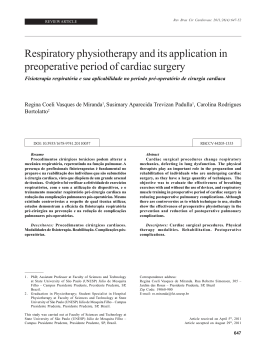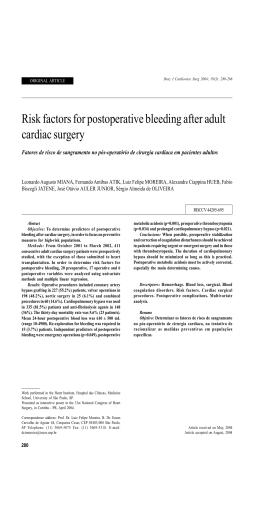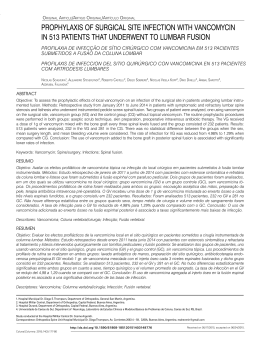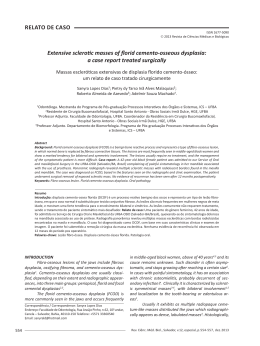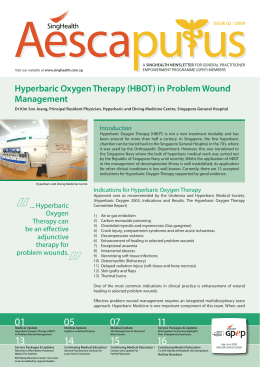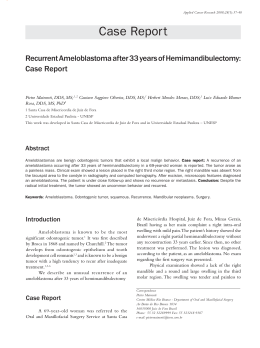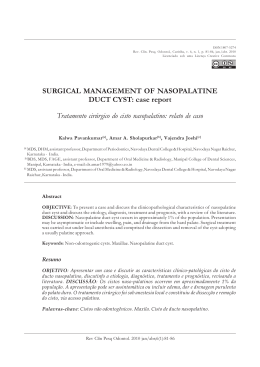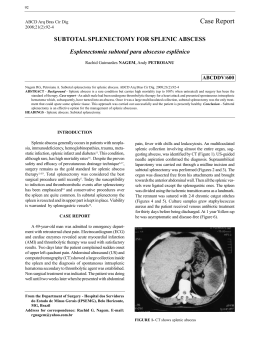| EXPERIENCE REPORT | PREOPERATIVE UNIT: A NEW PROPOSAL FOR SERVICES AND MANAGEMENT Unidade pré-operatória: uma nova proposta de atendimento e gestão Unidad de preparación quirúrgica: una nueva propuesta de servicios y gestión Daniela Magalhães Bispo1, Ana Lucia Silva Mirancos da Cunha2, Cristina Silva Sousa3, Ivana Lucia Correa Pimentel de Siqueira4 ABSTRACT: Objective: To present the results of the implementation process of a preoperative unit. Method: Descriptive and analytical study including experience report, with the goal of reporting the implementation of a preoperative unit in a private general hospital in the city of São Paulo, as well as the experience of the professionals involved. Results: The efficiency of a preoperative unit was confirmed as an optimization strategy for the surgical center, whose processes are established with agility by a team focused on this type of patient. Conclusion: The preoperative unit was established as an opportunity to minimize the lack of beds, to centralize services to streamline them, and to promote greater integration and continuity of preoperative care to the assistance proposed by the surgical center, as well as a better organization of administrative and health-care activities. KEYWORDS: Preoperative Care. Perioperative Nursing. Health Services Administration. RESUMO: Objetivo: Apresentar os resultados do processo da implantação de uma Unidade Pré-operatória. Método: Estudo descritivo e analítico tipo relato de experiência, tendo como meta o relato da implantação de uma unidade pré-operatória em um hospital geral privado, localizado no município de São Paulo, e da experiência dos profissionais envolvidos. Resultados: Constatou-se a eficiência de uma unidade pré-operatória como estratégia de otimização do centro cirúrgico, estabelecendo os processos com agilidade por uma equipe com olhar focado neste tipo de paciente. Conclusão: A Unidade Préoperatória foi implantada como uma oportunidade de minimização da falta de leitos, visando centralizar serviços de forma a agilizá-lo,com o objetivo de promover maior integração e continuidade dos cuidados pré-operatórios à assistência proposta pelo Centro Cirúrgico, além de melhor organização das atividades administrativas e assistenciais. PALAVRAS-CHAVE: Cuidados pré-operatórios. Enfermagem perioperatória. Administração de serviços de saúde. RESUMEN: Objetivo: Presentar los resultados del proceso de la implementación de una unidad de preparación quirúrgica. Método: Estudio descriptivo y analítico incluyendo relato de experiencia, con el objetivo de orientar la implementación de una unidad de preparación quirúrgica en un hospital general privado en la ciudad de São Paulo y relatar la experiencia de los profesionales involucrados. Resultados: La eficiencia de una unidad de preparación quirúrgica como estrategia de optimización del centro quirúrgico y el establecimiento de procesos agiles conducidos por un equipo enfocado en el paciente quirúrgico. Conclusión: La unidad de preparación quirúrgica se estableció como una oportunidad para reducir al mínimo la indisponibilidad de camas, para centralizar los servicios de manera ágil con el fin de promover una mayor integración y continuidad de la asistencia para el cuidado preoperatorio propuesto por el Centro Quirúrgico y una mejor organización de las actividades administrativas y asistenciales. PALABRAS CLAVE: Cuidados Preoperatorios. Enfermería Perioperatoria. Administración de los Servicios de la Salud. Graduation Student in Technological Management and Innovations at Instituto Sírio Libanês de Ensino e Pesquisa; Senior Nurse in the Preoperative/Surgical Center of Hospital Sírio Libanês. E-mail: [email protected] Rua Tucunduva, 433, 63-1. Vila São Vicente, CEP 02733-100. São Paulo, SP, Brasil. Telefone: (11) 39325459 / (11) 988224141 / (11) 33944834. PhD in Adult Health from the Nursing School at Universidade de São Paulo (EEUSP); Coordinator Nurse of the Anesthesia Recovery and Surgical Center at Hospital Sírio-Libanês. E-mail: [email protected] 3 Doctorate in Adult Health Nursing at EEUSP; Full Nurse of the Surgical Center at Hospital Sírio-Libanês. E-mail: [email protected] 4 Nursing doctorate at EEUSP. Service and Surgery Superintendent at Hospital Sírio-Libanês. E-mail: [email protected] Received: 11 Dec. 2014 – Approved: 4 Feb. 2015 DOI: 10.5327/Z1414-4425201500010008 1 2 | 53 | REV. SOBECC, SÃO PAULO. JAN./MAR. 2015; 20(1): 53-62 BISPO DM, CUNHA ALSM, SOUSA CS, SIQUEIRA ILCP INTRODUCTION Recently, much has been studied about processes focused on quality and efficiency. In hospital management, one of the greatest challenges is providing service for an increasing number of patients, taking into consideration the insufficient number of available beds and humanization aspects. Hospital organizations are among the ones with the most complex management, not only due to the nobility and amplitude of their work but especially due to inclusion of a multidisciplinary team to provide health support in preventive, curative, and rehabilitating characters. It is also an environment to teach and learn and to develop scientific production1. In addition to this rationale, there are also production and costs, that is, the business sustainability. Offering a proposal with real value for the client is part of a business strategy and is an item in the service system2. The continuous search by the institutions for improvement of their services has been the differential for their permanence and for standing out in the market where they operate. Satisfying needs or even overcoming them is fundamental because client’s satisfaction becomes an essential factor for the survival of companies, especially services companies whose products are characterized by intangibility3. A study that assessed hospital and ambulatory service offer and production in public and private hospitals found in 2009 a deficit of 22,216 hospital beds in Brazil. With regard to the number of surgical hospitalizations, 23.2% increase was observed, which is in agreement with the 16.8% population growth, even though 18.4% decrease in the number of beds was observed4. Therefore, managing beds with efficacy became urgent in hospital life, especially considering the turnover dynamics in surgical hospitalizations and possible complications. To this fact, we can add the excellence in providing services, a riveting and recent concern. Another element directly associated with the dynamics of bed management and service offer is surgical movement, which is considered a variable that interferes in quality and productivity indicators of hospital institutions. The following are included as parameters of productivity evaluation in the surgery room: occupation rate, permanence time, anesthesia recovery, time interval between surgeries, delay time, and surgery suspension5. Good performance measurement of a surgical center (SC) is directly associated with quality of its own processes and as a consequence with the services that support it, a combination between physical, technological installations, and appropriate equipment used by a qualified, trained, and competent staff6. Thus, the idea of hospital bed optimization emerged in our institution. In May 2012, a preoperative unit was structured with the aim of integrating service of the surgical hospitalization unit to the preexistent routines of the SC through centralizing the control in this team and optimizing not only the hospital beds but also the preoperative preparation processes. The strategy used to optimize the preoperative unit processes was developed from the service routine of anesthesia recovery. This unit receives the patient after a surgical procedure, where he/she should remain until he/she recovers full awareness and have stable vital signs, always under observation and constant care of the SC nursing team. This staff should prevent intercurrences from the postanesthesia period and/or, if they may happen, provide the patient with the appropriate treatment7. In our institution, this unit can accommodate patients on transportation stretchers, and curtains separate the beds. It has a minimum stock of disposable materials and medications for the immediate postoperatory service, with support of the satellite drug store, located inside the SC. The preoperative unit has physical, material, technological, and human resources similar to those of the anesthesia recovery; however, they are directed for patient’s service in the preoperative phase. Materials/medications are requested through Personal Digital Assistant, which allows immediate drug management without the need of request and delivery of requested medication to the central drug store. Because it is a small unit with simple accommodation, the nurse developed a strategy for choosing patients for admission. The established criteria include adult patients without motor deficit, in elective surgery without colon preparation, and with hospitalization on the surgery date. On the eve of the scheduled date of surgery, the program is checked and those patients listed in the program are chosen for acceptance in the preoperative unit according to the selection criteria predetermined by the unit. After the selection, the nurse plans nursing support in the preoperative period. This planning consists of signalizing the actions that should be done with the patients according to the proposed surgery, and information in the request for hospitalization/surgery, followed by the surgeon’s medical practice. | 54 | REV. SOBECC, SÃO PAULO. JAN./MAR. 2015; 20(1): 53-62 PREOPERATIVE UNIT: A NEW PROPOSAL FOR SERVICES AND MANAGEMENT The nursing service prescription is structured focusing on the surgical preparation. Therefore, at hospitalization day, it may be possible that the nursing technician begins patient’s care as soon as he/she arrives in the unit. All printed papers are verified as soon as the medical record is delivered to the management assistant, who is oriented in the event to signalize any abeyances or disagreements from what is preconized by the institution. The required documents are the following: free informed consent for the surgery; hospitalization/surgery request, with all the information regarding the surgical scheduling; patient’s identification; diagnosis; examinations that led to such diagnosis; preoperative prescription; date and time of surgery; and surgical time and necessary materials for the intra-operative period. Besides the verification of documents, heart and laboratory examinations, preanesthesia evaluation form, and anesthesia informed consent are separated in a writing board to facilitate the anesthesiologist’s visit. Nursing evaluation and planning are also in writing boards to avoid the manipulation of medical records by several professionals in short period. This dynamic has been more effective. Focus of the team at preoperative preparation ensures caution verification, which favors the accomplishment of all stages: nursing preoperative evaluation; preanesthetic visit; vital signs verification; trichotomy and asepsis of the surgical area; blood sample swab for blood group system and lab examinations; electrocardiogram; verification of documents required by the institution for patient’s follow-up until the SC; marker of surgery area (laterality) when applicable; and emotional comfort through humanized service, valuing the differences and particularities of every subject, favoring anxiety and stress decrease in the preoperative stage. The mark of surgery area (laterality) aims at identifying, with no ambiguities, the place of the surgical procedure. For procedures that involve the difference between bilateral structures (right and left), multiple structures (such as fingers and toes) or multiple levels (such as in spine procedures), the place must be marked in a way that the mark is visible after the patient has been prepared8. This study aimed at presenting results of the implementation process of a preoperative unit. METHOD This descriptive and analytical study aimed at implementing a preoperative unit. It was a report experience of professionals from a private and philanthropic general hospital, in the city of São Paulo, Brazil. Delay to begin surgeries impacts all the planning of surgical and dynamic schedule in an SC. Distance between the SC and hospitalization unities and accessibility to elevators are factors that lead to these delays. Closeness to the SC was a determinant factor to implement the preoperative unit in such area, which is located on the same floor as the SC as a neighbor unit. The unit has eight beds with transportation stretcher and separation through curtains, which is similar to the aspect of unities of anesthesia recovery or emergency rooms. It has a bathroom for the patients from these beds and independent rooms with four small suites, composed of beds with stretchers and an exclusive bathroom with shower, separated through drywalls — an edification of lighter and thinner plaster walls than masonry walls —, and a sliding door. From the physical characteristics of the unit, it would not be possible to meet all the service demands in the surgical program completely, with the need of choosing patients who may be treated in the area with no damage to preoperative nursing assistance. For example, because there are four suites with shower, criteria are required for choosing patients who need trichotomy and bath at the same time as surgery. Thus, we thought about making patient’s selection based on the characteristics of the surgery with regard to the physical plan and profile of the unit for a faster dynamics. The best moment would be the day before the surgical program. In this unit, patients are present only in the preoperative period, not at postoperative period. This is different from the day clinic sector, or day hospital, seen in other institutions. Thus, a nurse from the unit was chosen to perform the patient’s selection to the bed control sector, based on the following criteria: patients who do not need to be hospitalized on the eve of surgery; surgical procedures with no intestinal preparation; adult patients; and patients with no mobility deficit. The amount of available beds and their turnover, that is, time when the bed would be free and clean again for another patient’s acceptance, focusing on the surgical program, was also taken into consideration. For an appropriate performance of the preoperative preparation, in this unit, the following procedures were carried out: multidisciplinary evaluation, lab examinations, electrocardiogram, trichotomy, hygiene, and asepsis of the surgery area; bath with chlorhexidine is recommended for abdominal | 55 | REV. SOBECC, SÃO PAULO. JAN./MAR. 2015; 20(1): 53-62 BISPO DM, CUNHA ALSM, SOUSA CS, SIQUEIRA ILCP surgeries or those of large bones. If the nurse finds it necessary, he/she can bathe the patient, taking into consideration each patient’s individuality and rules by the Commission of Hospital Infection Control of the institution. The nurse orients patients and their companions about the service provided and the continuity of service until anesthesia recovery. Another relevant aspect is the optimization of specific materials that can be reduced due to use minimization. After anesthesia recovery discharge, the patient and his/her companion are taken to an apartment. During stay in the preoperative unit, patient’s belongings are locked in a closet. The concierge is the professional who talks to relatives and companions while the patient is in the SC. To keep process agility, we chose nursing professionals with great knowledge and experience in the area. Need of acquaintance with the surgical procedure and with the orientations for this preparation resulted in the selection of an assistance team that is mainly composed by professionals from the SC, as well as the nursing coordination. Professionals remained wearing privative clothing to keep the characteristic of a restricted unit, and the nearness to the SC facilitates the transition from the unities if necessary. After the beginning of the activities in such sector, professionals started performing support activities only in the preoperative unit. To evaluate process management, we chose indicators for measuring the results of the unit, considering the unit acceptance flow, surgeries indicated without delay, and demarcation of laterality or mark of the surgery area. Because this is a private institution, an intervention was necessary together with the surgeons, which was done through an invitation to be aware of the unit proposal and of its facilities, besides explanation of the working process, inviting them to release their patients’ acceptance. For this study, we also wanted to measure the perception of physical clients about the unit. To do so, the researcher developed an instrument with the following items: hospitalization logistics; focused service; preparation time agility; and deficiency in accommodations. The creation of a unit was based on American and European services, which consist of accommodating patients in the preoperative unit in a place next to the surgery block, with support from the SC team that has specialized technical knowledge about the preparation and turnover of patients. Every item presented multiple-choice answers and, in the end, there was a space for commentaries (Appendix 1). This instrument was validated through an interdisciplinary discussion with professionals from the areas of service and surgeries superintendence, anesthesiologists, surgeries, and nursing team from the SC. The evaluation period comprised October to November 2012. A letter explaining the objective of fulfilling the research instrument, with no commitment, was provided to each medical professional who was cared in the unit. For those who wished to answer, the instrument was delivered as a service satisfaction research. The answered instruments were put in an envelope and analyzed in future time. RESULTS After 6 months of the unit implementation, we observed an increase of surgeon’s interest for their patients’ acceptance. This reflects on the achievement of primary objectives of the unit installation, optimization of hospital beds, and process of surgical patient assistance though the focused care. As to the applied instrument, 33 clients from different medical categories (Figure 1) were consulted, who answered about the preoperative unit. We observed that 100% mentioned that the unit significantly contributed for the work plan due to the agility in the patient’s preparation to be followed to the SC. In Table 1 we present the percentages of answers to the instrument applied to medical teams. An improvement was also observed in the decrease of time associated with hospitalization logistics for 97% professional respondents because the patient is taken to the bed where there is a focused service in the surgical patient’s preparation. For 91% of them, the unit has brought a significant improvement for the client, which is associated with process agility. Of the interviewed subjects, 61% answered that the unit totally overcomes the lack of accommodations, even though there is still a need for improvements; on the other hand, 85% said this area implementation following American and European models was a right decision from the hospital director. The medical team’s satisfaction toward the unit has been observed in reports about the perception of the unit and the developed service. Here are some of the statements written in the space to commentaries in the evaluation instrument: Since there are beds exclusively to the preoperative period, we do not need to book a room, which | 56 | REV. SOBECC, SÃO PAULO. JAN./MAR. 2015; 20(1): 53-62 PREOPERATIVE UNIT: A NEW PROPOSAL FOR SERVICES AND MANAGEMENT Orthopedic Plastics Thoracic Ophthalmology Gynecology/ Mastology Urology Oncological mastology Otolaryngology Cardiology Anesthesiology Figure 1. Distribution of medical specialties that answered to the research instrument, São Paulo-SP, Brazil, 2012. can take a long time if the hospital is full. Nursing is faster because it is focused on surgical preparation. Before this, preoperative period took more than twice the time spent. Now, with the new unit, the process is much faster. The patients and relatives’ great anxiety is towards the procedure, so they prefer to make such process faster. (S1) Table 1. Percentage of answers of the applied instrument, São Paulo-SP, Brazil, 2012. Variables n % Improvement in time reduction 32 97 Nonsignificant change in this process 1 3 Change damaged the process – 0 There was a significant improvement for the client 30 91 It kept the same results obtained in the IU 3 9 There was no improvement – 0 It significantly contributes for the working plan 33 100 It did not change the routine – 0 Agility in the process totally overcomes this deficiency 20 61 It partially overcomes 12 36 It does not overcome because it brings unpleasantness to clients 1 3 It was a correct decision from the institution director 28 85 It was not a correct decision, because it caused a negative impact in the clients’ perception – 0 It was a correct management decision, but accommodations must be improved 5 15 Hospitalization logistics Focused service There has been great improvement in logistics, making preoperative scheduling much easier and decreasing arrival time of the patient in the SC… It is the only visit in great hospitals in São Paulo and contributes to decreasing hospitalization time, and the delay in the beginning of surgical procedures has also decreased. (S3) With regard to the division of the unit as to the physical floor plan and accommodation, absence of a private bathroom for the eight beds was reported as a point to be improved, as seen in the following comment: Preparation time agility Deficiency in accommodations Unit following American and European services Personal care overcomes the physical space. Lack of a private bathroom is important. (S2) However, another perspective reports that it does not compromise the service. | 57 | REV. SOBECC, SÃO PAULO. JAN./MAR. 2015; 20(1): 53-62 BISPO DM, CUNHA ALSM, SOUSA CS, SIQUEIRA ILCP Accommodations are good; they do not compromise the process efficiency. (S3) As a suggestion, the previous presentation of the unit standouts. In order to avoid the negative impact of the accommodation, there should be a previous explanation for the patient about the unit pit stop, giving emphasis to its profile and objectives, mentioning especially that this is a sector integrated to the SC. (S1) With regard to the evaluated indicators, a reduction was observed in the delays to being surgeries (Figure 2). Nearness with the SC facilitated the search for the patient and the preoperative contact with the team members. Nearness and knowledge of professionals from the SC brought to the unit demarcation of laterality (Figure 3) and correct fulfillment of the needed forms. In January 2012, the occupation rate was 84%; in February 87%; in March 90.3%; and in April 88.8%. After the unit opening in May 2012, higher values were observed with the following percentages: May, 91.7%; June, 93.1%; July, 91.6%; August, 89%; September, 91.3%; October, 91%; November, 87%; and December, 87.3%. DISCUSSION Results from this study showed the eff iciency of a preoperative unit as a strategy of SC optimization by 100% 80% 83% 90% 92% 85% 85% 80% establishing the processes with agility using a team focused on such patients. In a study carried out in 2003, in Arizona, the USA, the multidisciplinary team of a hospital was gathered with the aim of proposing strategies to decrease the preparation time of surgical patients that they were ready 30 minutes before the time of surgery. The preoperative area was prepared with this purpose and the dynamic processes were determined, besides the team’s preparation. Ninety-eight patients were followed and as a result the researchers obtained a 7% decrease in delays to prepare patients, which was not considered very significant. However, the research allowed recognizing that the possibility of fast, efficient, and safe service may also be developed in health institutions9. In an attempt to dialogue with the mentioned experience, besides proposing efficient and dynamic processes, making patient’s preparation and follow-up to the SC faster and avoiding delays in the beginning of the procedure, we tried to meet all the requirements of the quality insurance Joint Commission on Accreditation of Healthcare Organizations ( JCAHO) and to know the doctor client’s impressions. In 2004, JCAHO implanted the Universal Protocol, which includes the following elements: preoperative verification, surgical area marker, and timeout process at intraoperative period10. Time out is a pause that consists of a fundamental stage performed in a surgical room before the beginning of the procedure, and it aims at evaluating and ensuring that the patient, surgical place, procedure, and positioning are correct and all documents, equipment, and information are available. In this stage, all conference processes are done orally, 85% 60% 40% 20% 0% Mean Jan/13 Feb/13 Mar/13 Apr/13 May/13June/13 July/13 Aug/13 Sep/13 Oct/13 Nov/13 Dec/13 2012 Delay Goal Figure 2. Indicator of number of surgeries beginning with no delay, São Paulo-SP, Brazil, 2013. | 58 | REV. SOBECC, SÃO PAULO. JAN./MAR. 2015; 20(1): 53-62 PREOPERATIVE UNIT: A NEW PROPOSAL FOR SERVICES AND MANAGEMENT 120% 100% 93% 100% 100% 100% 100% 100% 98% 80% 60% 0% 0% 0% 0% Oct/13 Nov/13 Dec/13 June/13 May/13 Apr/13 Mar/13 Feb/13 Jan/13 Mean/12 Dermaked 0% July/13 0% 0% Sep/13 20% Aug/13 40% Goal Figure 3. Indicator of surgical laterality marker, São Paulo-SP, Brazil, 2013. in loud voice, and with the participation of all the members of the surgical team. It is also required the interruption of all and any activity in the room. Reading of items is integrally and exactly as written in the patient’s medical record8. The first step of JCAHO Universal Protocol, the preoperative verification, aims at ensuring that all relevant documents and information and equipment are available before the beginning of the procedure, with correct identification and labeled according to the patient’s identification register and consistent with the patient’s expectations and with team’s comprehension regarding the patient, procedure, and place of surgery. Lack of information or discrepancies must be approached and solved before the beginning of the surgical procedure8,11. Due to the nearness with the SC (on the same floor), it was easier to mark the laterality by the medical professional and the completion of all required documents. Furthermore, the SC also adds gains to the new model, given the higher control of operationalization of surgery plan through the decrease in delays and higher facility of rescheduling, when necessary. In the results from this study, laterality marker reached 100% levels, and excellence in care regarding goal 1 of safe surgery from the World Health Organization (correct identification of the patient and surgical place). These levels could not be achieved in other studies: in one at Porto Alegre (RS, Brazil), 81.5% professionals adhered to the first laterality marker, and 15.3% to the second one12. As to surgery delay, the new unit allowed that the indicators were kept within the predetermined goal of above 80%. In another study, surgery delay was the main justification seen in surgical suspensions13, with 28 reports (60.90%). The surgery suspension is known to result in a substantial loss of financial return to the SC because it demands inactive hour of the operation room and of the collaborator, reducing therefore the financial return. Another evident fact seen in this study was the high rate of hospital occupation indices, evidenced by the percentages measured in the months after the preoperative unit opening. Until the opening of this unit, beds — that were scheduled in the day before surgeries — were available, which improved patient’s distribution and avoided inactivity of the apartments because many times the postsurgical destinations of the patients are changed due to the need of another kind of unit. This is a new concept of patient’s care, taking into consideration more efficient processes and resource optimization, not forgetting about the attention and “human heat” in the service. FINAL CONSIDERATIONS The preoperative unit was implemented as an opportunity of decreasing the scarcity of beds, aiming at centralizing | 59 | REV. SOBECC, SÃO PAULO. JAN./MAR. 2015; 20(1): 53-62 BISPO DM, CUNHA ALSM, SOUSA CS, SIQUEIRA ILCP services to make them faster and to promote more integration and continuity of preoperative care to the service proposed by the SC unit. Thus, we understand that results, until now, have been very relevant to the institution and provide a better advance in the management and assistance activities. This stimulate us, in an expansion period, to plan a physical structure that may provide more comfort to our clients and their companions or relatives, besides the increase of scientific knowledge associated with technical qualification and a positive attitude, which ensure service quality and professional competence. Therefore, we will continue searching for resources to reach our goals. We believe that these results may be used as an encouragement for other institutions to seek improvement in their services development. REFERENCES 1. Gurgel Junior GD, Vieira MMF. Qualidade total e administração hospitalar: explorando disjunções conceituais. Ciênc Saúde Coletiva. 2002;7(2):325-34. 2. Corrêa HL, Caon M. Gestão de serviços: lucratividade por meio de operações e de satisfação dos clientes. São Paulo: Atlas; 2002. recomendadas SOBECC: centro cirúrgico, recuperação anestésica e centro de material e esterilização. 6. ed. São Paulo: Manole; 2013. 8. Joint Commission Resources. Papel do enfermeiro na segurança do paciente e nos resultados do atendimento. In: Temas e estratégias para liderança em enfermagem: enfrentando os desafios hospitalares atuais. Porto Alegre: Artmed; 2008. p. 107-41 3. Cerili D, Ceretta GF, Rocha AC, Canterile NMG. Análise da satisfação dos usuários dos serviços de clínicas médica e cirúrgica em um hospital do Sudoeste do Paraná. RAHIS. 2014;11(2):106-22. 9. Celik J. Decreasing perioperative delays – a rapid process improvement project. AORN J. 2003;77(4):737-41. 4. Mendes ACG, Sá DA, Miranda GMD, Lyra TM, Tavares RAW. Assistência pública de saúde no contexto da transição demográfica brasileira: exigências atuais e futuras. Cad Saúde Publica. 2012;28(5):955-64. 10.Conrardy JA, Brenek B, Myers S. Determining the state of knowledge for implementing the universal protocol recommendations: an integrative review of the literature. AORN J. 2010;92(2):194-207. 5. Perroca MG, Jericó MC, Facudin SD. Monitorando o cancelamento de procedimentos cirúrgicos: indicador de desempenho organizacional. Rev Esc Enferm USP. 2007;41(1):113-9. 11.Vendramini RCR, Silva EA, Ferreira KASL, Possari JF, Baia WRM. Patient safety in oncology surgery: experience of the São Paulo State Cancer Institute. Rev Esc Enferm USP. 2010;44(3):827-32. 6. Santos MC, Rennó CSN. Indicadores de qualidade da assistência de enfermagem em centro cirúrgico: revisão integrativa da literatura. RAS. 2013;15(58):27-36. 12.Santos CM, Caragnato RCA, Moraes CS. Equipe cirúrgica:adesão à meta 1 da cirurgia segura. Rev SOBECC. 2013;18(4):47-56. 7. Sociedade Brasileira de Enfermeiros de Centro cirúrgico, Recuperação Anestésica e Centro de Material e Esterilização – SOBECC. Práticas 13.Barbosa MH, Miranda Gourlat DM, Vieira de Andrade E, De Mattia AL. Análise da suspensão de cirurgias em um hospital de ensino. Enferm Glob. 2012;26:174-83. | 60 | REV. SOBECC, SÃO PAULO. JAN./MAR. 2015; 20(1): 53-62 PREOPERATIVE UNIT: A NEW PROPOSAL FOR SERVICES AND MANAGEMENT ANEXO 1 – INSTRUMENTO DE COLETA DE DADOS SUPERINTENDÊNCIA DE ATENDIMENTO E OPERAÇÕES UNIDADE PRÉ-OPERATÓRIA Enfª Daniela Magalhães Bispo A Unidade Pré-operatória foi estruturada para integrar o preparo dos pacientes cirúrgicos ao ambiente e rotinas já vigentes ao Centro Cirúrgico, centralizando o controle a esta equipe. Assim, os pacientes que não necessitam internação na véspera da cirurgia são admitidos nesta Unidade, onde é realizada a avaliação multidisciplinar, exames, tricotomia, higienização e antissepsia, além de receber todas as informações necessárias junto a um acompanhante, agilizando, assim, a sua chegada à sala operatória. O intuito deste questionário é saber a opinião dos senhores sobre a unidade e os benefícios proporcionados, bem como receber sugestões para futuras melhorias. INSTRUMENTO DE COLETA DE DADOS ESPECIALIDADE MÉDICA:_____________________________ 1. Referente à logística da internação até a chegada do cliente à Unidade Pré-operatória versus unidade de internação (apartamento). Você considera que ocorreu: ( ) melhoria em redução de tempo ( ) a mudança neste processo não foi significativa ( ) a mudança prejudicou o processo Comentários:________________________________________________________________ 2. Referente ao atendimento focado prestado ao paciente nesta unidade, como: avaliação de enfermagem, avaliação anestésica, tricotomia, antissepsia, proximidade ao CC, marcação da lateralidade, marcação para cirurgia plástica, preenchimento dos impressos necessários. Você considera que: ( ) Houve melhoria significativa para o seu cliente ( ) Manteve os mesmos resultados obtidos nas unidades de Internação ( ) Não houve melhoria Comentários:____________________________________________________ 3. A Unidade Pré-operatória mediu os tempos de preparo e os avaliou até o momento do “paciente pronto para o CC”, com tempo médio de 30’ e mediana de 10’ à 40’.Você considera que esta agilidade: ( ) Contribuiu significativamente para o seu plano de trabalho ( ) Não alterou sua rotina Comentários:________________________________________ 4. Reconhecendo o padrão de excelência dos nossos clientes, a Unidade Pré-operatória foi criada com o objetivo de agilizar o processo. No entanto, temos a convicção de que melhorias nas acomodações são necessárias. Você considera que: ( ) A agilidade no processo compensa totalmente esta deficiência ( ) Compensa parcialmente ( ) Não compensa, pois traz dissabores aos seus clientes Comentário:______________________________________________________________________________________ | 61 | REV. SOBECC, SÃO PAULO. JAN./MAR. 2015; 20(1): 53-62 BISPO DM, CUNHA ALSM, SOUSA CS, SIQUEIRA ILCP 5. Em relação à implantação da Unidade Pré-operatória ter sido baseada em serviços americanos e europeus, que buscam eficiência no processo, você considera que: ( ) Foi uma decisão acertada da direção da instituição, a implantação desta área ( ) Não foi uma decisão acertada, pois impactou negativamente na percepção dos clientes ( ) Foi uma decisão administrativa correta, mas as acomodações devem melhorar Comentários:__________________________________________________________________________________ SUGESTÕES: _________________________________________________________________________________ _______________________________________________________________________________________________ ________________________________________________________________________________________________ | 62 | REV. SOBECC, SÃO PAULO. JAN./MAR. 2015; 20(1): 53-62
Download









